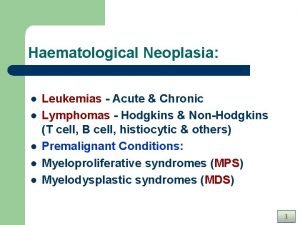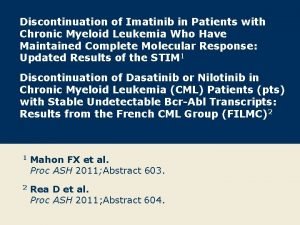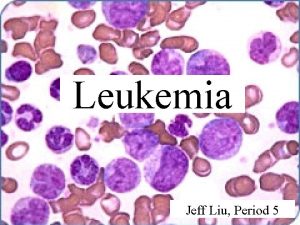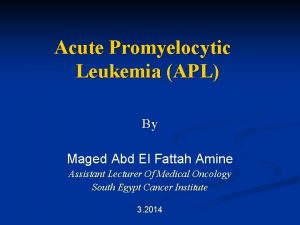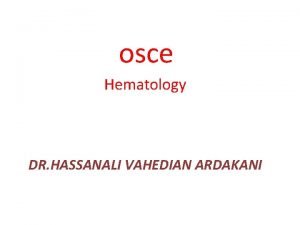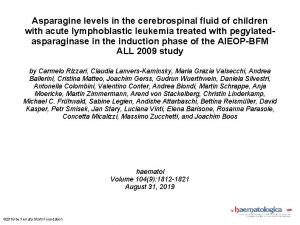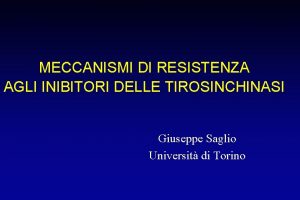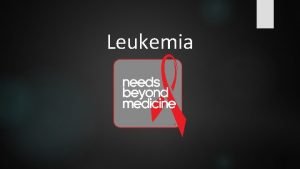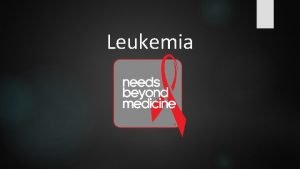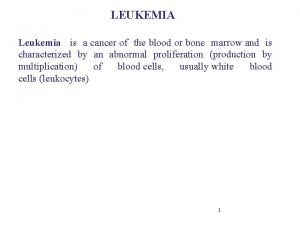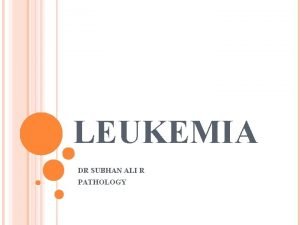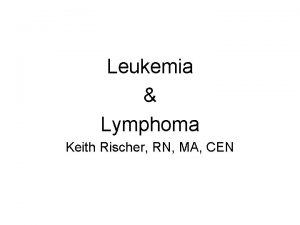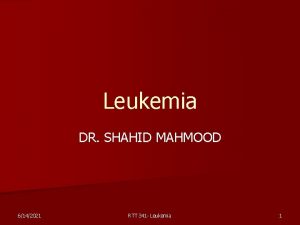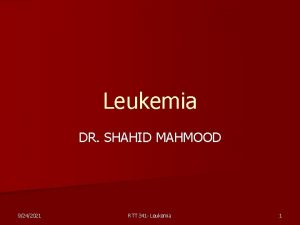Leukemia What Is Leukemia Leukemia is cancer of


















- Slides: 18

Leukemia

What Is Leukemia? ❏ Leukemia is cancer of the blood-forming tissues ❏ Begins in the bone marrow when abnormal blood cells are produced ❏ Usually involves white blood cells

Statistics from the United States ❏ 2019 Estimates for Leukemia ❏ In 2019, 61, 780 people are expected to be diagnosed with Leukemia. ❏ There an estimated 399, 967 people living with Leukemia in the United States. ❏ In 2019, 22, 840 people are expected to die from Leukemia.

Types of Leukemia ❏ Acute Lymphocytic Leukemia ❏ Chronic Lymphocytic Leukemia ❏ Acute Myeloid Leukemia ❏ Chronic Myelomonocytic Leukemia

Acute Lymphocytic Leukemia ❏ More common in children than adults ❏ Starts in the bone marrow with immature white blood cells ❏ Rapid onset ❏ Most common Leukemia type that affects children

Chronic Lymphocytic Leukemia ❏ Accounts for ⅓ of all Leukemia cases ❏ Builds slowly over time; usually asymptomatic for a few years ❏ Can eventually spread to the lymph nodes, liver, and spleen ❏ Mainly affects older adults

Acute Myeloid Leukemia ❏ Most common in older adults ❏ Occurs when there is a DNA mutation in the bone marrow ❏ Can occur from inherited gene mutations, but most commonly occurs from acquired gene mutations ❏ Does not typically form tumors, but is widespread throughout the bone marrow, blood, and occasionally the liver or spleen

Chronic Myeloid Leukemia ❏ About 15% of Leukemias in adults are Chronic Myeloid Leukemia ❏ In Chronic Myeloid Leukemia, a genetic change takes place in immature myeloid cells (the cells that make red blood cells, platelets, and most types of white blood cells)

Chronic Myelomonocytic Leukemia ❏ Very rare; only occurs in 4 of every 1, 000 people in the United States each year ❏ Many people with Chronic Myelomonocytic Leukemia have too many monocytes ❏ Mainly affects older adults ❏ About 15% to 30% of people with Chronic Myelomonocytic Leukemia later develop Acute Myeloid Leukemia

Leukemia in Children ❏ Leukemia is the most common cancer in children ❏ Most childhood Leukemias are acute; chronic Leukemias are rare in children ❏ Acute Leukemias can progress quickly, and should be treated right away. ❏ Chronic Leukemias progress at a slower rate, but can be more difficult to treat

Risk Factors ❏ Exposure to high levels of radiation ❏ Previous cancer treatment ❏ Genetic disorders ❏ Having a compromised immune system ❏ Family history of leukemia ❏ Exposure to certain chemicals ❏ Smoking


Tests and Exams ❏ If your doctor suspects Leukemia, he or she may: ❏ Ask for medical history ❏ Check for enlarged lymph nodes in the neck, underarm, and groin ❏ Check for an enlarged liver or spleen ❏ Do a complete blood count and blood chemistry test ❏ Do a bone marrow aspiration and biopsy

How to Test for Leukemia Type ❏ Biopsy of lymph, bone, and other tissues ❏ Blood test ❏ Cytogenetic analysis ❏ Immunophenotyping ❏ Chest x-rays ❏ CT scan ❏ Lumbar puncture

Treatment ❏ Chemotherapy: kills Leukemia cells using anti-cancer drugs ❏ Radiation therapy: kills cancer cells with high energy radiation ❏ Interferon therapy: slows the reproduction of Leukemia cells and promotes the immune system’s anti-leukemia activity ❏ Stem cell transplantation: aids in treatment with high levels of chemotherapy and radiation ❏ Surgery: to remove enlarged spleen or to install venous access device

Survival Rates ❏ The 5 -year relative survival rate for Leukemia has more than quadrupled from 1963 to 2014. ❏ From 2007 to 2013, the 5 -year relative survival rates were: ❏ Acute Lymphocytic Leukemia: 71. 6%; 90. 6% for children under 15 ❏ Chronic Lymphocytic Leukemia: 86. 8% ❏ Acute Myeloid Leukemia: 28. 1% overall; 68. 8% for children under 15 ❏ Chronic Myeloid Leukemia: 68. 7%

Mission Statement Needs Beyond Medicine is dedicated to helping cancer patients pay for non-medical expenses while undergoing medical treatment. Our mission is to decrease the burden of cancer by increasing awareness, education, and relief to cancer patients. Needs Beyond Medicine is focused in an effort to offer assistance toward enhancing the quality of life for those diagnosed with cancer through educational and financial support.

Follow Us! @Needs. Beyond. Med Facebook Instagram Twitter Linked. In You. Tube
 Chronic myeloid leukemia
Chronic myeloid leukemia Lll leukemia
Lll leukemia Allogeneic stem cell transplant
Allogeneic stem cell transplant Leukemia
Leukemia Chronic myeloid leukemia
Chronic myeloid leukemia Acute mylogenous leukemia
Acute mylogenous leukemia Differentiation syndrome
Differentiation syndrome Principle of pas stain
Principle of pas stain Trombopoetik adalah
Trombopoetik adalah Leukemia statics
Leukemia statics Chronic myeloid leukemia
Chronic myeloid leukemia What does the suffix penia mean in medical terms
What does the suffix penia mean in medical terms Myelobast
Myelobast Krvná plazma funkcia
Krvná plazma funkcia Nk leukemia
Nk leukemia Platelet clumper
Platelet clumper Asparagine
Asparagine Zhang wang leukemia
Zhang wang leukemia Hairy cell leukemia
Hairy cell leukemia

